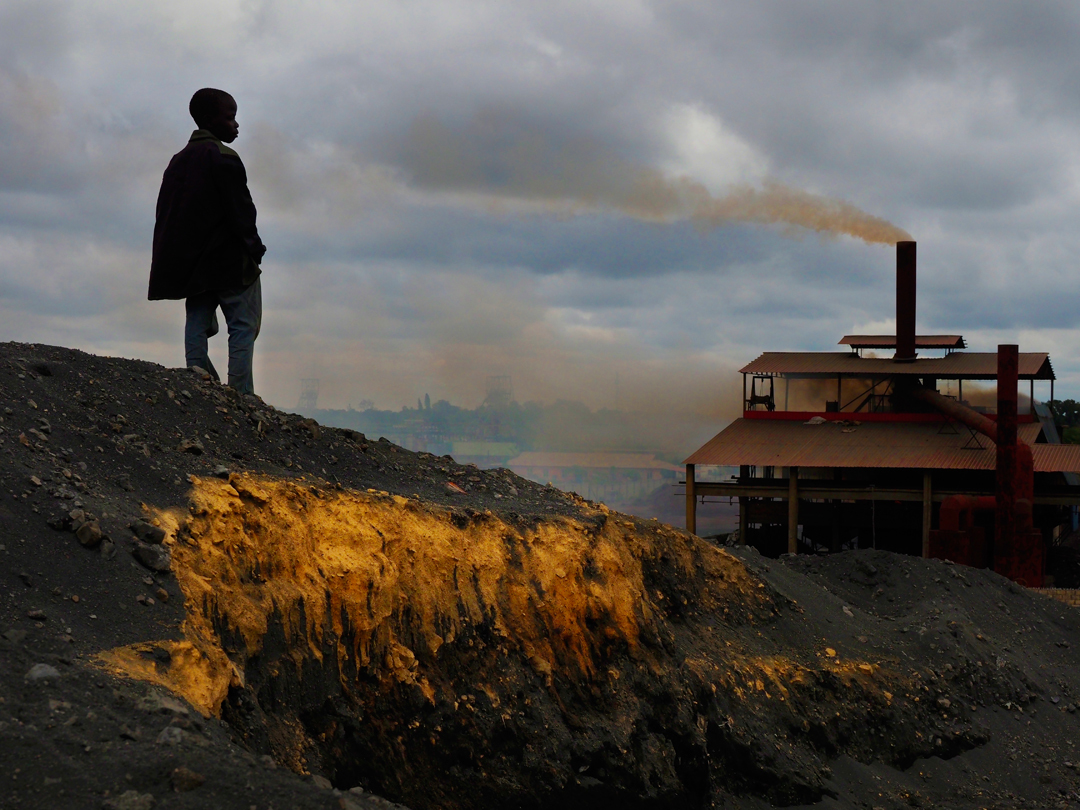Kabwe, Zambia
The perimeter wall stretches from the main complex of the former Zambia Consolidated Copper Mines Ltd. east along a two-lane dirt road. The road has been here for as long as anyone can remember. It's one artery that provided access to Kabwe's sprawling mining complex that began operation here in 1904.
Kabwe sits squarely on one of the continent's largest deposits of lead and copper. Without the mineral bounty that lies beneath the red earth, it's doubtful Kabwe would even exist.
These days, Kabwe is a sprawling city of 220,000. It also has the distinction of being among the most polluted places on Earth. The mine was shuttered in 1994, but a hundred years of production has come at a terrible cost. Strewn across the land, millions of tonnes of red and black mining slag rise up from the surface, creating a toxic dune that continues to poison the residents of Kabwe. Blowing dust and seasonal rains disperse the mine waste, contaminating streets, yards, homes, and water supplies. Lead pollution is a constant menace for those in the neighborhoods closest to the mine. Many residents have higher than normal blood lead levels—and most at risk are the children.
As I walk along the road, I encounter dozens of people walking or biking along the shoulder. Every now and again, the words "DANGER" appear in large letters painted on the 7-foot cement-block wall that runs for more than a mile on the road's north side.
Eventually the wall bends north to reveal a crude opening large enough for lorries to pass. The gateway looks makeshift, likely the result of an assault with sledge hammers. Beyond the opening, a rocky landscape stretches far into the distance. Nearby, men and women walk beside a huge vehicle, struggling under the weight of tonnes of rock. The lorry barely clears the opening and rumbles past me.
This is where the rock crushers work. They are the scavengers who come to this place to work the toxic soil, filling woven plastic sacks with rocks and dirt, crushing large stones with tiny hammers. They labor in earth that measures up to 5.5 percent pure lead, breathing the dust, poisoning themselves.
I take the opportunity to make a few images, catching the attention of the men guarding the portal. I smile and nod their way. They wave back as I approach. Soon others, curious, form a small group around as I explain that I'm interested in their work. One man, speaking excellent English, isn't enthusiastic about my presence and tells me not to take any more photographs. "No flashing," he says firmly. Translated, this means, "No photos."
I smile, keeping my camera at my side and start asking a few questions about the work here. Others chime in, explaining this is a restricted area. I ask about the work again, pointing to the hundreds of neatly arranged pyramids of small stones that line the paths behind the opening. A man tells me that the workers gather each day at 6 a.m., weather permitting, and dig rocks and soil using picks and shovels. Men use heavier tools and iron bars to pry at the chunks of earth. Women and children use hammers to break and stack the larger rocks. Others use shovels to fill bags with finer soil. I learn the area was once a grassy plateau. Now it's a red wasteland of polluted soil, systematically dumped here over the years.
This area is highly contaminated with lead. Women, children, and men work here day in and day out, using their bare hands to make a living repackaging toxic waste. The rocks and soil is sold to middlemen as raw material to produce concrete and bricks for new homes and buildings.
I explain that I'm a journalist and am here to share their story. The man who decidedly was against me making photographs now seems to understand. "Tell the truth," he says, as he turns to return to work. Others nod and shuffle away. I walk through wall and follow the ruts worn by the vehicles. As I begin photographing again, no one seems to pay attention.
After a few hundred yards, the road gives way to a network of rocky paths. I notice a group in the distance. As I approach, I see a family working together to dig and break rocks. Two women smile as I raise my camera. Without breaking their rhythm, they continue to smash at the melon-sized rocks.
Nearby, two children struggle to lift sacks of rocks they've been dispatched to gather. One pulls so hard, he loses his balance and almost falls over. The load is too heavy for the other boy so he drags the sack through the dirt. They're unaware as I make several images, determined in their work. I think about this sad scene unfolding and deduce the rocks are likely half their weight. Finally, the boys drag the bags to the worksite where their mother, Debola Kunda, continues to hammer and add to the neatly stacked piles of stone. Debola laughs as the boys plop down next to her. I ask for names and Debola tells me Abraham is 6 and his younger brother Acili is 4.
I continue to walk and photograph. I come across more groups of workers frantically stabbing the ground with picks and shovels. Along a ridge of hard, red crush, Ackson Mwansa uses a spike to pry large rock from beneath several feet of lead slag. I photograph the process and then he pauses for a short rest.
Ackson reflects on the long trench that's formed then looks me in the eyes. "We work hard to feed our families," he says.
























